Celsus Library › Celts › Stone Age Tools » Origins and History
Articles and Definitions › Contents
- Celsus Library › Origins
- Celts › Who Was
- Stone Age Tools › Origins
Ancient civilizations › Historical places, and their characters
Celsus Library › Origins
Definition and Origins

The Celsus Library of Ephesus, named after the city ’s former Roman governor and constructed in the 2nd century CE, was a repository of over 12,000 scrolls and one of the most impressive buildings in the Roman Empire.
Commissioned in 114 CE by Tiberius Julius Acquila, the library was built to commemorate his father Tiberius Julius Celsus Polemaeanus, who had been, from 105 to 107 CE, the Roman proconsul of Ephesus, the then capital of Rome ’s Asian province. Celsus had also been consul in Rome in 92 CE, where he was responsible for all public buildings. The library was probably completed in 117 CE. Celsus himself was entombed under the library in a lead coffin encased in a decorated marble sarcophagus.
THE LIBRARY IS A TYPICAL EXAMPLE OF THE ARCHITECTURAL STYLE PREVALENT IN THE PERIOD UNDER EMPEROR HADRIAN.
The library stands at the corner of Curetes street and the Marble road at the very heart of the city, just to the left of the agora, near its monumental arched entrance. The library is a typical example of the architectural style prevalent in the period under Emperor Hadrian (76-138 CE). Resting on a nine-stepped podium 21m in length, the impressive surviving facade is richly decorated with relief carvings and has two stories - each with three pairs of columns capped with Corinthian capitals. The library had three entrance doorways flanked by four statues set back in niches. These figures with inscribed bases represented four qualities associated with the late governor: wisdom ( sophia ), intelligence ( ennoia ), knowledge ( episteme ) and virtue ( arete ).

Celsus Library, Ephesos
The interior of the library measured 16.72m by 10.92m and was paved with decorated marble. The walls were lined with niches for storage of the scrolls. Running around the interior wall at second-story level, was a railed balcony giving access to higher level niches. In order to reduce humidity and create a more stable interior temperature (which would have damaged the precious texts within the library), empty niches were constructed inside the walls. The interior also contained a large alcove which contained a statue, probably of Celsus.
In 262 CE the library was destroyed by fire during a Gothic invasion. However, the facade survived and repairs were made to the library in the 4th century CE and a fountain added in front.
Celts › Origins
Definition and Origins
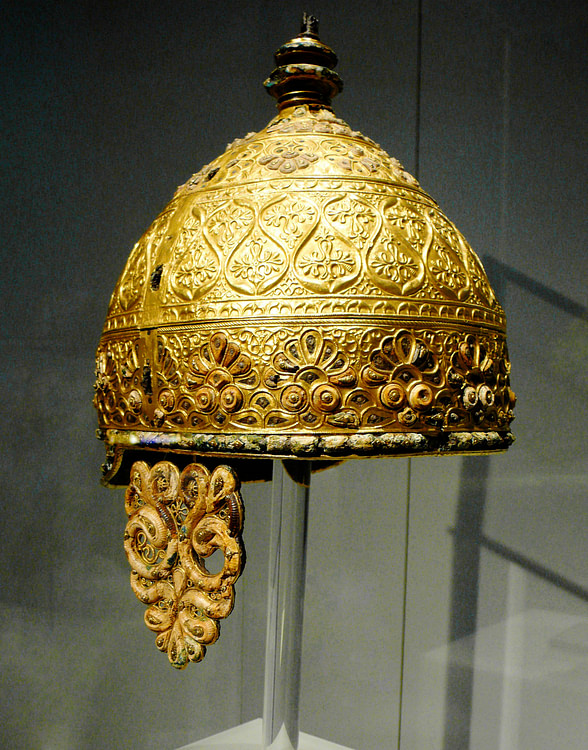
The ancient Celts were various population groups living in several parts of Europe north of the Mediterranean region from the Late Bronze Age onwards. Given the name Celt by ancient writers, these tribes often migrated and so eventually occupied territories from Portugal to Turkey. Although diverse tribes the ancient Celts spoke the same language and maintained the same artistic tradition which is characterised by the use of idiosyncratic flowing lines and forms. Celtic languages are still spoken today in parts of the British Isles and northern France.
GEOGRAPHICAL SPREAD
Ancient writers gave the name Celts to various population groups living across central Europe inland from the Mediterranean coastal areas. Most scholars agree that the Celtic culture first appeared in the Late Bronze Age in the area of the upper Danube sometime around the 13th century BCE. These early Celts were known as the 'Urnfield people' and they probably spoke a proto-Celtic language. By the 8th century BCE, iron had replaced bronze-working and the cultural group is then referred to by scholars as the 'Hallstatt culture'. Spain saw a similar development with tribes using iron weapons. The Hallstatt culture declined by the 5th century BCE, perhaps due to internal political tensions and economic difficulties. The next phase of Celtic development was carried out by a group known as the La Tène culture.
THE MIGRATION OF VARIOUS CELTIC TRIBES IN ORDER TO FLEE WARS MEANT THAT EVENTUALLY THEY OCCUPIED TERRITORY FROM THE IBERIAN PENINSULA TO TURKEY.
The prosperity of the La Tène culture in ancient France, Spain and wider central Europe meant that they were able to challenge the contemporary Mediterranean cultures and so they appear for the first time in Classical history. From then on these peoples were widely referred to as Celts. In antiquity writers did not describe tribes in ancient Britain and Ireland as Celts, although they have acquired that label in modern times and some Celtic languages or their derivatives are still spoken there, as a form of Celtic still is in the Brittany region of northern France. The religion of the Celts, led by a priesthood known as the Druids, is described by ancient writers with some disdain as crude and violent.
The migration of various Celtic tribes in order to flee wars – they were famously attacked in Gaul by Julius Caesar in the 1st century BCE and by the Germanic tribes - and find new prospects meant that eventually the territory occupied by them ranged from Galicia (the Iberian peninsula) to Romania. Many Celtic tribes spread eastwards, for example, traversing Macedonia in 280 BCE and crossing the Hellespont in 278 BCE into Asia Minor. The Galatians, as they were now called, colonised areas of central Asia Minor which brought them into direct conflict with both the Hellenistic kingdoms and Rome.
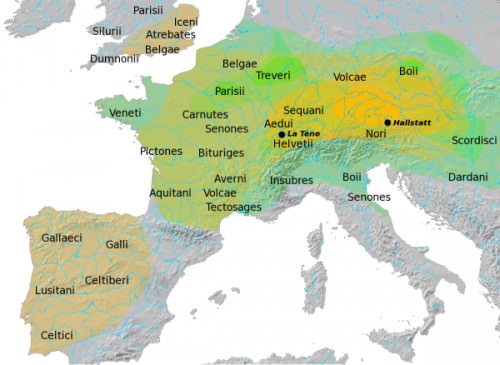
Hallstatt & La Tène Cultures
CELTIC WARFARE
Celtic armies first came to the attention of historians when the Gauls, led by their king Bran (Brennus), sacked Rome in 390 BCE, and again in 279 BCE when they looted Delphi as they passed through Greece on their way to Asia. The Celts attacked the Romans again in 225 BCE and were frequent mercenary allies of Carthage during the Punic Wars. The Celts thus gained a reputation with Latin and Greek writers for being fierce warriors and skilled horsemen who also fielded chariots in battle.Julius Caesar faced them when he invaded Gaul. They were light, pulled by two horses, and had an open front and back with double hoops at the sides. Containing two men they were used to attack enemy cavalry first by throwing javelins and then one man dismounted to fight on foot while the rider drove the chariot to a safe distance to await a retreat if necessary. Caesar describes them as driven with great skill and so were a highly manoeuvrable weapon of disruption and attack.
Celtic warriors were known for their long hair and imposing physique. They are depicted in Greek art with their distinctive long shields (wooden panels covered in decorated hide) and long swords. Such was the respect for Celtic warriors that Hellenistic kings who defeated Galatian armies were given the title of soter, meaning 'saviour'. Although Galatian armies were almost always defeated by their more disciplined and better-equipped enemies in single battles, once conquered, they did fight successfully as mercenaries in many Hellenistic and Roman armies.
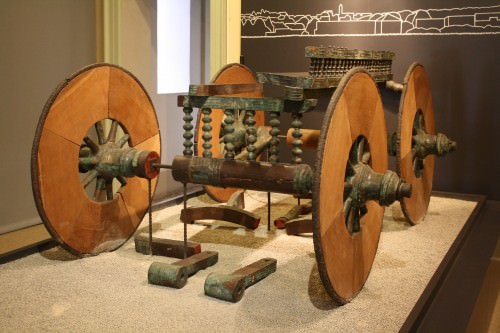
Celtic Wagon
CELTIC LANGUAGES
The Celtic language is a branch of the Indo-European language family. Scholars have divided Celtic languages into two groups: Insular Celtic and Continental Celtic. The latter group was no longer widely spoken after the Roman imperial period, and the only surviving examples of it are mentions in the works of Greek and Roman writers and some epigraphic remains such as pottery graffiti and votive and funerary stelae. The best documented of this group is Gaulish.
The Insular Celtic group of languages are two: British or Brittonic (Breton, Cornish, and Welsh) and Goidelic (Irish and its medieval derivatives, Scots Gaelic and Manx). Brittonic was spoken in all of Britain in the Roman period. From it evolved Cumbrian (extinct since medieval times), Cornish (no longer spoken after the 18th century CE but recently revived), Breton (likely introduced by 5th-century CE British settlers and not connected directly to Gaulish), and Welsh, which is still spoken today. The earliest evidence of Goidelic-Irish dates to the 5th century CE, and it later evolved into Middle Irish (c. 950 – 1200 CE) and, thereafter, morphed again into Modern Irish, which is still spoken today.
Stone Age Tools › Origins
Ancient Civilizations
As the Stone Age covers around 99% of our human technological history, it would seem there is a lot to talk about when looking at the development of tools in this period. Despite our reliance on the sometimes scarce archaeological record, this is definitely the case.
The Stone Age indicates the large swathe of time during which stone was widely used to make implements. So far, the first stone tools have been dated to roughly 2,6 million years ago. The end is set at the first use of bronze, which did not come into play at the same time everywhere; the Near East was the first to enter the Bronze Age around 3,300 BCE. It must be recognised that stone was by no means the only material used for tools throughout this time, yet it is the most stubborn one when it comes to decaying and thus survives a bit better than the alternatives.
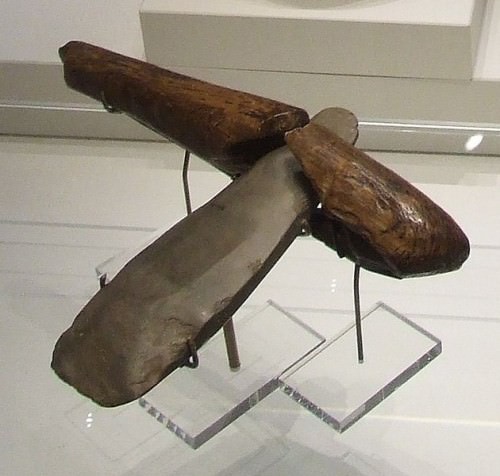
Neolithic Stone Axe with Wooden Handle
TIME PERIODS
It is important to realise that the ways chosen to divide up the Stone Age into bite-size chunks (see below) depend on technological development, and not on chronological boundaries. Because these developments did not occur at the same time in all areas, strict date ranges are out of the question. Of course, this method has some difficulties, as the characteristics defining each stone tool culture are determined by us. As with all such artificially constructed ways of classification, they oversimplify things and leave many grey areas, for instance when it comes to transition periods. However, as long as this is kept in mind it is still a useful way of adding some sort of structure to such a hugely long period of time.
The Stone Age is conceived to consist of:
- the Palaeolithic (or Old Stone Age)
- the Mesolithic (or Middle Stone Age)
- the Neolithic (or New Stone Age)
The Palaeolithic spans the time from the first known stone tools, dated to c. 2,6 million years ago, to the end of the last Ice Age around 12,000 years ago. It is further subdivided into the Early- or Lower Palaeolithic (c. 2,6 million years ago - c. 250,000 years ago); the Middle Palaeolithic (c. 250,000 years ago - c. 30,000 years ago); and the Late- or Upper Palaeolithic (c. 50,000/40,000 - c. 10,000 years ago; some of these cultures persisted into the time when the Northern Hemisphere began warming up again). Furthermore, within these frameworks, various stone cultures are identified, some of which you will find below.
The Mesolithic saw humans adapt to the warmer climate, from around 12,000 BCE until the transition to agriculture, which happened at different times in different regions, the earliest of which was around 9,000 BCE in the Near East (which due to its lightning speed sort of skipped the Mesolithic altogether). At the other extreme, farming took until around 4,000 BCE to spread all the way to Northern Europe.

Middle Palaeolithic Hand Axe
The Neolithic, then, has no clear chronological starting point either, but is defined by the move to a more settled way of life based on farming and herding. The introduction of bronze marks the end of the Neolithic, which gradually happened in various areas from around 3,300 BCE onward.
THE EARLIEST TOOLS
A claim went out in 2010 CE that the earliest evidence for tool use should be pushed back to the astonishing age of 3,3 million years ago – well before the first Homo are known to have roamed the earth, the first appearance of which was recently pushed back to around 2,8 million years ago. Our supposed ancestors, the contemporary Australopithecus afarensis, are held responsible for producing marks on bovid bones at a site in Dikika, Ethiopia. Moreover, a discovery in West Turkana, Kenya of stone tools dated to 3,3 million years seems to further bolster the idea that humans might not have been the first tool users.
THE EARLIEST PROPERLY ACCOUNTED TOOL USE DATES TO 2,6 MILLION YEARS AGO.
However, a more critical evaluation of both sites has led researchers to reject these claims. The Dikika marks could also have been made by crocodile teeth or by trampling, and the West Turkana site may have suffered from materials from younger layers sliding down into the deposit, resulting in an incorrect date. Until these possibilities have been ruled out, the evidence must be seen as insufficient.
This does not mean, though, that humans were the only ones that can be conceived to have used tools. All of the hominins that were around at that early time may have used some sort of stone technology to a greater or lesser extent. Hominins are the group that consist of modern humans, extinct human species, and our immediate ancestors – species that are more closely related to modern humans than to anything else. This includes not only members of the genera Homo, but also of Australopithecus (to which the famous Lucy belongs), Paranthropus, and Ardipithecus. Many anthropologists argue that Homo was likely the more habitual tool user and maker, as its brain size grew so quickly over the first million years after the earliest properly accounted tool use at 2,6 million years ago, and its teeth size declined. This could only have happened if there were tools to compensate for the smaller teeth. It is possibly just a waiting game, though, until the first rock-solid documentation of non-Homo tool use comes to light.
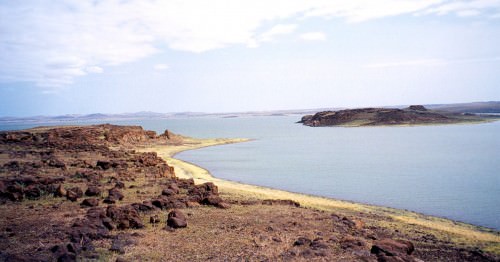
Lake Turkana, Kenya
Although some animals - like chimpanzees, that are known to use sticks to dig for termites - use some sort of tools, the manufacturing process of these early stone artefacts is unique to hominins. Despite the simplicity of early stone tools they still showcase a deliberate and controlled way of fracturing rock by using percussive blows – something which highlights a definite behavioural innovation.
THE EARLY- OR LOWER PALAEOLITHIC
The Early Palaeolithic begins with the first evidence we have of stone (also known as lithic) technology, which has so far been dated to around 2,6 million years ago and stems from sites in Ethiopia. Two industries are recognised in this period, namely the Oldowan and the Acheulean. It lasts up to roughly 250,000 years ago, until the onset of the Middle Palaeolithic.
The Oldowan
The Oldowan industry is named after Olduvai Gorge in Tanzania and comprises the earliest stone industry visible in our archaeological record. It is characterised by simple cores and flaked pieces, found alongside some battered artefacts like hammerstones, as well as the occasional animal bones showing cut marks.
Although there is no clear end point, and it coexisted for some time with the later Acheulean industry (which began around 1,7 million years ago), archaeologists usually draw the finish line around 1 million years ago when referring to the Oldowan.Oldowan sites are first and foremost known from Africa (in places like Ethiopia, Kenya, and South Africa), but are later seen to spread towards the Near East and eastern Asia, probably carried there by Homo erectus.

Oldowan Chopper
At these sites, simple technologies were used to turn materials such as volcanic lavas, quartz, and quartzite into tools via techniques known as hard hammer percussion and bipolar technique, in which a stone anvil serves as a base to rest the core on while it is hit with a stone hammer. This way, cores were turned into choppers, heavy-duty scrapers and the likes; battered percussors like hammerstones and spheroids; flakes and fragments struck from rotated and manipulated cores; and retouched pieces such as scrapers and awls. It is clear these early humans were skilled and knew how to get the most out of a piece, seeing that sites often show dozens of flaked cores accompanied by thousands of flake products, indicating that many flakes were hammered from the same core piece.
THE EARLY TOOLS WERE MOST LIKELY USED TO HELP THESE HUMANS BUTCHER ANIMALS, CUT UP PLANTS, & EVEN DO SOME WOODWORKING.
These early tools were most likely used to help these humans butcher animals (not always ones they had hunted themselves but likely also scavenged when possible), cut up plants, and even do some woodworking. Crawling into early human skins, researchers have done experiments that have shown that Oldowan flakes allow for a very successful butchering of carcasses ranging in size from small mammals to ones weighing hundreds of pounds, which reflects the range of bones that are typically found at these sites. The nutritious marrow inside the bones, and juicy brains inside strong skull cases, could be retrieved by cracking them open with a hammerstone. Stone is simply pretty good at standing the test of time, but it would not have been the only thing these people used in their daily lives. It is likely that a whole range of material spanning from skin and bark used to create containers; wood used to create digging sticks, spears or clubs; and digging tools made out of horn or bone were also used.
The Acheulean
While the Oldowan was still in full swing and had just about reached East Asia by the able hands of Homo erectus, Africa became the initial host to a second tool industry: the Acheulean (c. 1,7 million years ago to c. 250,000 years ago and named after St. Acheul in France), which spread far and wide across Eurasia a bit later on. It saw the development of tools into new shapes: large bifaces like hand axes, picks, cleavers and knives enabled the contemporary Homo erectus, and later on Homo heidelbergensis, to literally get a better grip on the processing of their kills and gatherings.
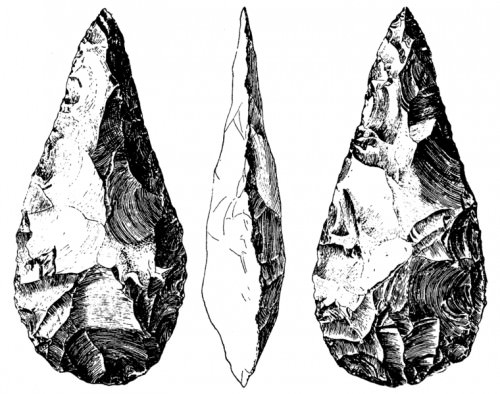
Acheulean Handaxe
These bifaces - ie two-faced, with a working surface on two sides - represent a new element in stone toolmaking. They were made from large flakes that were struck from boulder cores or from larger cobbles and nodules. Tools were more extensively shaped than before, as seen in the large range of proficiently created retouched tools such as backed knives, awls and side scrapers. It is the hand axes and cleavers in particular, though, that show the ability for creating symmetrical objects from stone materials, something that indicates a higher cognitive ability as well as motor skills than are visible in the Oldowan industry.
More precisely shaped tools meant a more delicate technique was needed; and indeed, softer materials such as wood, bone, antler, ivory, or soft stones, were now used as percussors in what is known as the soft hammer technique. Flint became a popular material, and by working it and the already familiar lavas and quartzites this technique produced thinner flakes that were then refined.
The Acheulean industry was successful and very widespread. It is found not only throughout Africa and Eurasia, but all the way to the Near East, the Indian subcontinent, as well as through Western Europe. Here, for the later Acheulean some impressive finds of sharpened wooden spears at Schöningen, Germany (dated to at least 300,000 years ago), and Clacton in England, provide the earliest evidence of active hunting and proper, designated hunting weaponry. They have been attributed to Homo heidelbergensis. Ice Age Europe would have presented some challenges in the shape of sometimes rather frigid weather conditions, especially at certain latitudes, but usage patterns on Acheulean side scrapers suggest that they were used to scrape hides that could then be turned into simple clothing. I would not be surprised if the snuggie blanket turned out to be much older than we think it is.
Interestingly, although the shape of hand axes varies widely throughout time and space, certain Acheulean sites show recurrent shapes and sizes that make it seem as if their makers all had a subscription to the same toolmaking magazine, as it looks like they all stuck to similar stylistic norms of production.
THE MIDDLE PALAEOLITHIC
The Middle Palaeolithic (c. 250,000 – c. 30,000 years ago, and sometimes called 'Mousterian' after the site of Le Moustier in France) marks a shift away from the boundless popularity of the hand axes and cleavers visible throughout the Acheulean.Instead, the focus came to lie on retouched forms made on flakes produced from carefully prepared cores using what is known as the Levallois technique – a technique which was also used to a small extent in the Early Palaeolithic and the Late Palaeolithic.
The use of this technique implied a careful preparation of the flint core by roughing it out first to give it a flattened face and designing a specific striking platform. This way, toolmakers could control the shape of the flake that was to be struck off. From these flakes, retouched forms such as side scrapers, points, denticulates, and sometimes blades were made, which are well-represented in many of these assemblages. Both hard hammer and soft hammer techniques were in use to help the toolmakers achieve their desired shapes.
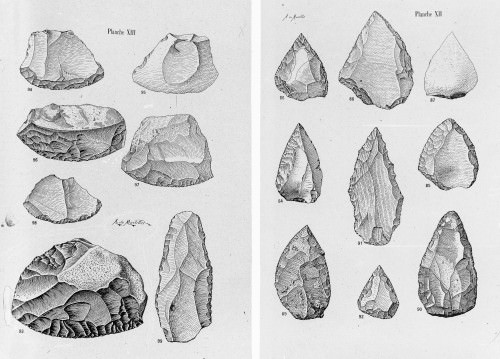
Drawings of Middle Palaeolithic Tools: Points & Scrapers
Besides stone, the technology for making wooden spears that had its roots in the Acheulean continued into the Middle Palaeolithic, as seen at the site of Lehringen, Germany, where a spear with a fire-hardened tip has been found and connected to an elephant carcass. Bone points, although rare, are also found within this industry. Also, stone points have been found that have thinned bases, which might indicate that they could have been hafted onto spear shafts. A discovery of the oldest known tar-hafted stone tools in Europe also falls within the general timeframe that corresponds with this industry, and along with the stone points mentioned above helps argue the case for the Middle Palaeolithic development of composite tools. The use of tar as an adhesive for hafting arrowheads and the like is otherwise known from several European Mesolithic and Neolithic sites – so not until a much later point in time.
All of the above hint at the fact that these Middle Palaeolithic humans may have been quite advanced. It has been argued that the steps and the forethought needed to successfully use the prepared core technique, for instance, would have demanded a considerable amount of skill from the maker. The beginning of hafting would seem to strengthen this notion. It is, however, hard to say whether this advance would have been mostly limited to the technological sphere, or whether it can be taken to mean a more general advance in human capabilities, such as with regard to social and environmental intelligence.
What is clear, though, is that humans spread across the globe into ever more challenging environments; most of the zones of Africa and Eurasia were conquered, ranging from tropical and temperate to periglacial climates, with the exception of harsh deserts, the denser of the tropical forests, and the very northernmost or arctic tundras. Late in this period (which overlaps with the Late Palaeolithic), humans even reached faraway Australia by around 40,000 years ago, which was connected to Papua New Guinea by the grace of lower sea levels at that time. Hominins that match the timeframe of this industry are archaic homo sapiens, including Neanderthals, and anatomically modern humans ( Homo sapiens sapiens ).
LATE- OR UPPER PALAEOLITHIC
There are areas in which the Middle Palaeolithic was retained for some time still, while others had since adopted the characteristics that push them into the Late Palaeolithic (c. 50,000/40,000 – c. 10,000 years ago), demonstrating a good example of the typical dating muddle that results from this technological way of classification. This industry recedes together with the ice sheets of the last glaciation or Ice Age, after which the climate warmed up. It is best known from sites occupied by anatomically modern humans, and is generally associated with them, but some of it also falls within the timeframe of the last populations of Neanderthals, who disappeared from the fossil record by approximately 30,000 years ago.

Creeping Hyena Spear Thrower of La Madeleine
The Late Palaeolithic saw a huge proliferation occur. Blade tools made of stone were created, but the emphasis shifted away from stone to artefacts made from materials such as bone, antler and ivory. Needles and points were made out of this non-lithic stuff, which lent itself excellently to these fine shapes, and their presence indicates that sewed clothes must have been the norm from 20,000 years ago onward. Even such technological feats as spear throwers, shaft straighteners, harpoons, and bows and arrows began to appear. A spear thrower is basically a long shaft with a hook on its end to which an arrow could be fitted, which would increase both the distance and the speed of the projectile hurtled by the capable hands of a keen-eyed hunter. Some of these were magnificently decorated with carvings, or were even carved into the actual shapes of animals; the Magdalenian culture of western Europe provides some stunning examples of this. Towards the end of the Late Palaeolithic, arrows (and thus, by implication, bows) were in use, as they have been found at a site in Stellmoor, Germany, and are implied by the small size of many of the points that occur in this industry. These mechanical devices represent a great leap in the advance of hunting technologies and weaponry.
The blade technologies are typical of the stone side of the industry, and show elongated flakes being produced by soft hammer or indirect percussion: a percussor struck a punch that was placed on the edge of a blade core. The resulting blades could be made into a whole array of tool forms such as backed knives, burins and end scrapers. The diversity of the Late Palaeolithic technologies meant that some of them, such as the Solutrean of Spain and France and the Clovis and Folsom ones of the New World, had their focus on bifacial points that may have been produced by soft hammer technique of by pressure flaking.Other technologies, such as African and some central- and eastern Asian ones, emphasised small blades known as bladelets and geometric microliths (small flint blades or fractions of blades) that were turned into composite tools and projectiles through hafting.

Magdalenian Bone Sewing Needle
Falling within the timeframe of both the Middle- and Late Palaeolithic, modern humans managed to reach Australia by about 40,000 years ago. However, it was not until relatively late into the Late Palaeolithic that we see the first evidence of humans making it across the Bering Strait and into the Americas, where they arrived by at least 15,000 years ago. The best visible culture there is the Clovis culture (c. 13,500 – c. 13,000 years ago), which is famous for its fluted spear points and is often connected with the remains of mammoths. Humans had by now conquered all feasible continents (Antarctica is not what one would consider within any realistic criteria) and climates ranging all the way from tropical to desert and stone-cold arctic climates, using this new range of tools to effectively exploit their environment and help them adapt to all of these different temperatures.
THE MESOLITHIC
The way humans adapted to new terrains and a wider range of climates throughout the Late Palaeolithic is a good precursor to the kind of adaptability that was required when the last glaciation or Ice Age ended round about 12,000 years ago. The climate warmed up, causing sea levels to rise, flooding low-lying coastal areas and creating, for instance, the English Channel, and more dense woodlands began to appear. Importantly, many giant prehistoric mammals such as woolly mammoths gradually went extinct, probably pushed by the climate and perhaps also by human hunters, impacting the sort of food sources that were available to contemporary hunter-gatherers. The Mesolithic, spanning from the end of the Ice Age to the transition to agriculture (which happened at different times in different regions), saw humans adapt to these changing environments.Whereas agriculture did not reach Northern Europe until around 4,000 BCE, in the Near East the Mesolithic barely began at all since it was the first place where the leap to farming was made around 9,000 BCE.
The archetypal tool of the Mesolithic (although it also occurs outside of this industry) is the microlith – a small flint blade or fraction of a blade, often only around 5 mm long and 4 mm thick. Striking a small core could produce the desired results, as could a technique in which a larger blade was notched and then a small portion snapped off. A by-product of this are tiny waste chips known as microburins, which the technique was named after. Microliths could be used as weapon- or arrow tips, or multiple microliths could be hafted together to create cutting edges on tools. In the Early Mesolithic, these microliths seem to be highly standardised relative to the same sort of items from the Later Mesolithic, which may hold clues to the different ways these people could have hunted.
THE HUGE PERCENTAGE OF ARROWHEADS PRESENT IN MESOLITHIC ASSEMBLAGES HINTS AT A HIGH PROBABILITY THAT THE MEATY PARTS OF THE MEALS THESE HUNTER-GATHERERS ATE HAD COME TO THEIR UNFORTUNATE END AT THE HANDS OF SKILLED BOWMEN.
Although the rich, imaginative decorations seen in the Late Palaeolithic are largely absent from the Mesolithic, these microliths show a development towards a very sophisticated and versatile composite tool type that was moreover a lot more efficient when it comes to the use of flint resources than previous industries had been. The huge percentage of arrowheads present in Mesolithic assemblages hints at a high probability that the meaty parts of the meals these hunter-gatherers ate had come to their unfortunate end at the hands of skilled bowmen. The sorts of prey these arrows could take down ranged from small animals like birds and fish to larger game such as onager and gazelle – who could be brought down with chisel-ended arrows.Barbs could also be fixed to arrows, which – as experiments have shown – proved very effective indeed at causing wide, gaping wounds once the arrow tip had entered its target. The bigger the wound was, the more damage internally, and the bigger the blood loss.
However, despite these Mesolithic people's weapons being very much capable of bringing down huge beasts, and because the number of huge beasts declined during this time, alternatives had to be found. Luckily, these hunter-gatherers successfully adapted to a more varied diet, using their arrows on many different animals, as well as developing sophisticated fishing gear, namely the first known nets and hooks. Mattocks and axes were even used to clear unwanted trees, and both canoes and skis have been found for this period. Bone adzes proved useful digging sticks for uprooting tubers, while awls could be used in both plant processing and for hide working. Scrapers, also used for defleshing, thinning and softening hides, were very popular in the Late Mesolithic, alongside similarly used bone and antler tools.

Mesolithic Harpoons & Lyngby Axe
Strikingly, it seems these people were able to get in touch with faraway societies in order to trade goods and tools, as seen in the spread of Mediterranean obsidian and in Polish chocolate -coloured flint. It must be emphasised that this age saw great regional variation.
THE NEOLITHIC
With the coming of agriculture, between around 9,000 BCE in the Near East and up to around 4,000 before it had spread all the way to Northern Europe, the lifestyles of the societies in question obviously changed drastically. This is the only part of the Stone Age in which the societies in question are no longer hunter-gatherers. However, as implied by the way we choose to let this age end with the start of the use of bronze (the first use of which was in the Near East around 3,300 BCE), the Neolithic still saw stone tools being used.
Despite this huge change to a more sedentary lifestyle, it is clear that some Mesolithic traditions carried over far into the Neolithic. Examples are bone and antler technologies and the use of projectile points. Harvesting knives and sickles have been found in both the Palaeolithic and the Mesolithic, as they had uses before farming, too, but they became popular in this new context. With regard to stone-working techniques such as grinding and drilling, which were not uncommon even in the later Palaeolithic, they now took on a whole new dimension and were applied much more fervently than before.
The biggest effect on technology seems to stem from the economic requirements of supporting a larger population (than the hunter-gatherer bands), like in villages. Such a fully sedentary lifestyle would have required less of a need for tools to be light and easy so they could be lugged across the terrain (it has been argued that there is a contrast between even the most sedentary hunter-gatherers and sedentary agriculturalists). A good example of a piece of equipment that would have been slightly impractical to carry by manpower only is the loom, which is almost exclusively known from agriculturalists, and which facilitated textile production. It is conceivable that tools used within textile production were among the first ones that appeared in the early Neolithic. A Neolithic site in Syria shows implements such as drills and reamers that may have been used for the joinery of wood – or joining pieces of wood together by using pegs and the likes.
If this all seems rather peaceful so far, do not be alarmed. Humans would not be humans if they did not also show a glimpse of a violent side. Axes are very visibly present in the Neolithic archaeological record; whole hoards of flint axes are known.However, other materials than flint were also used. These tools fall within the category of ground stone tools, were carefully polished, and could be hafted onto wooden handles. Rather than imagining nothing but rampaging hordes of axe warriors, however, a lot of them would have been work axes, used to fell trees rather than neighbouring people.
Sadly, as time went on and people transitioned through bronze and iron ages, from prehistory into history, all the way to today, the use (and killing potential) of weapons only seems to keep growing exponentially. I for my part prefer the old stones and other Stone Age tools.
LICENSE
Article based on information obtained from these sources:with permission from the Website Ancient History Encyclopedia
Content is available under License Creative Commons: Attribution-NonCommercial-ShareAlike 3.0 Unported. CC-BY-NC-SA License